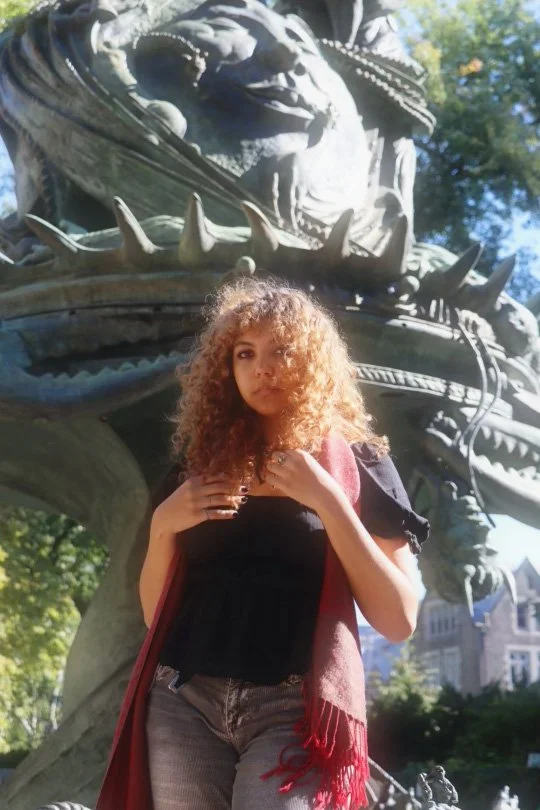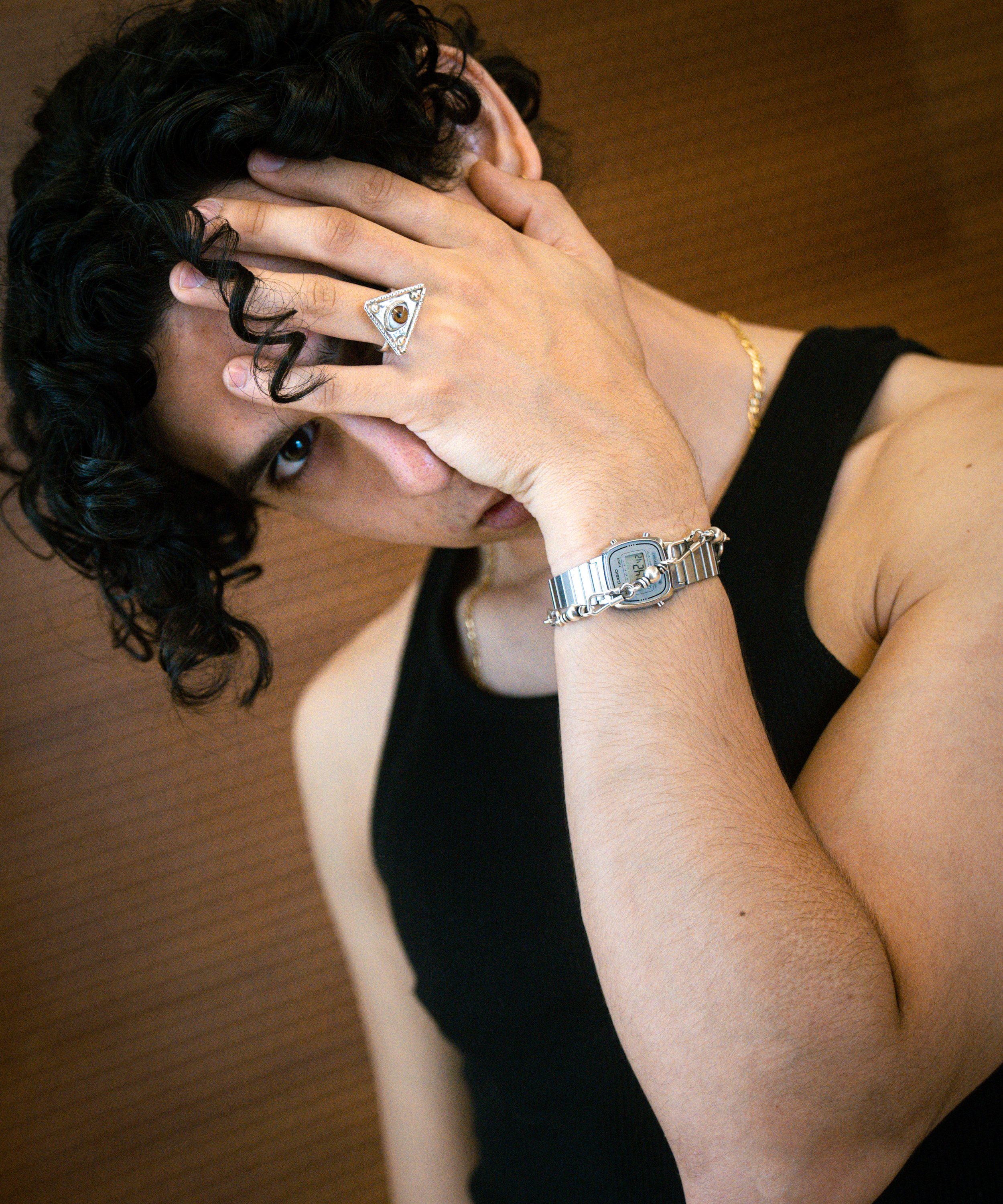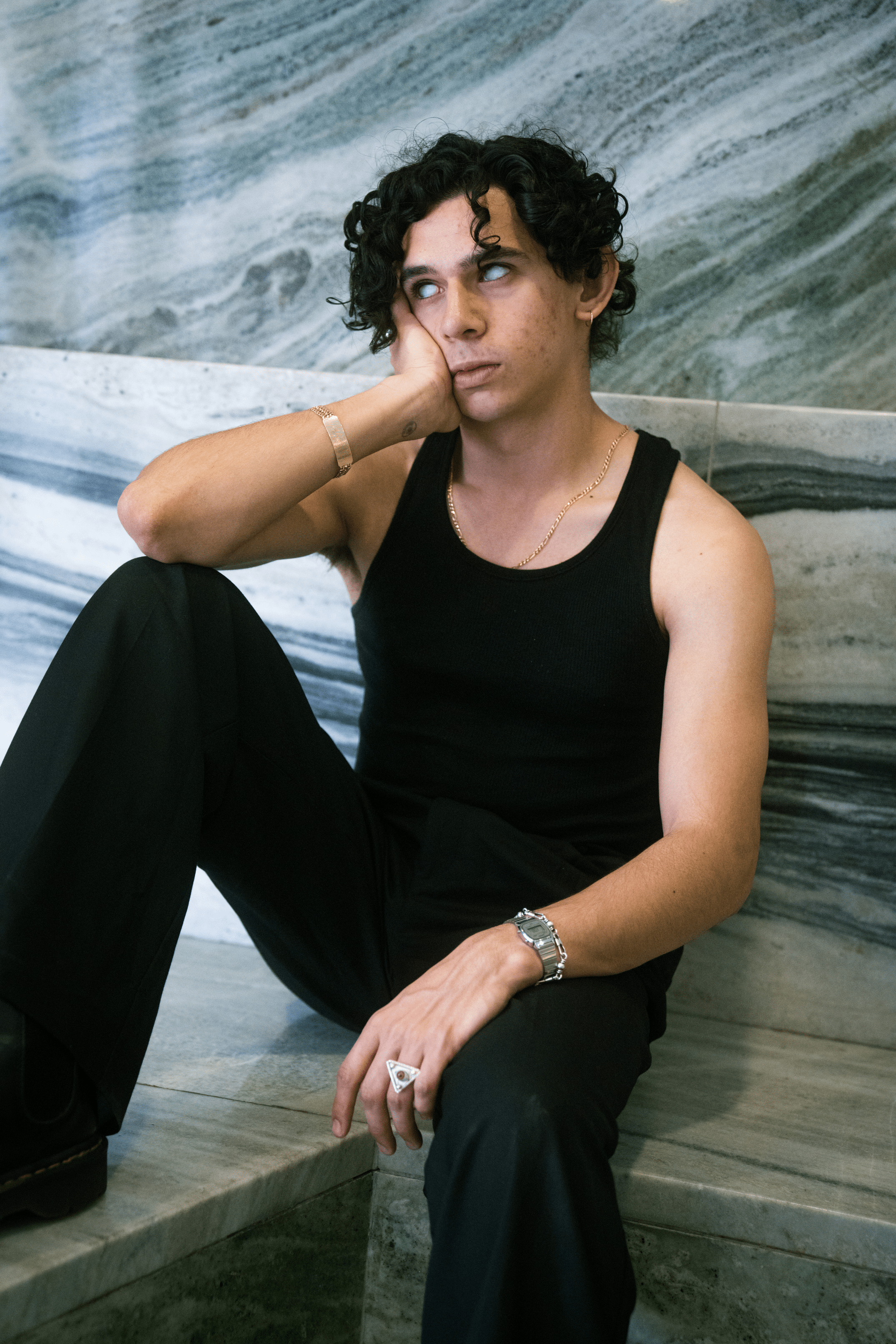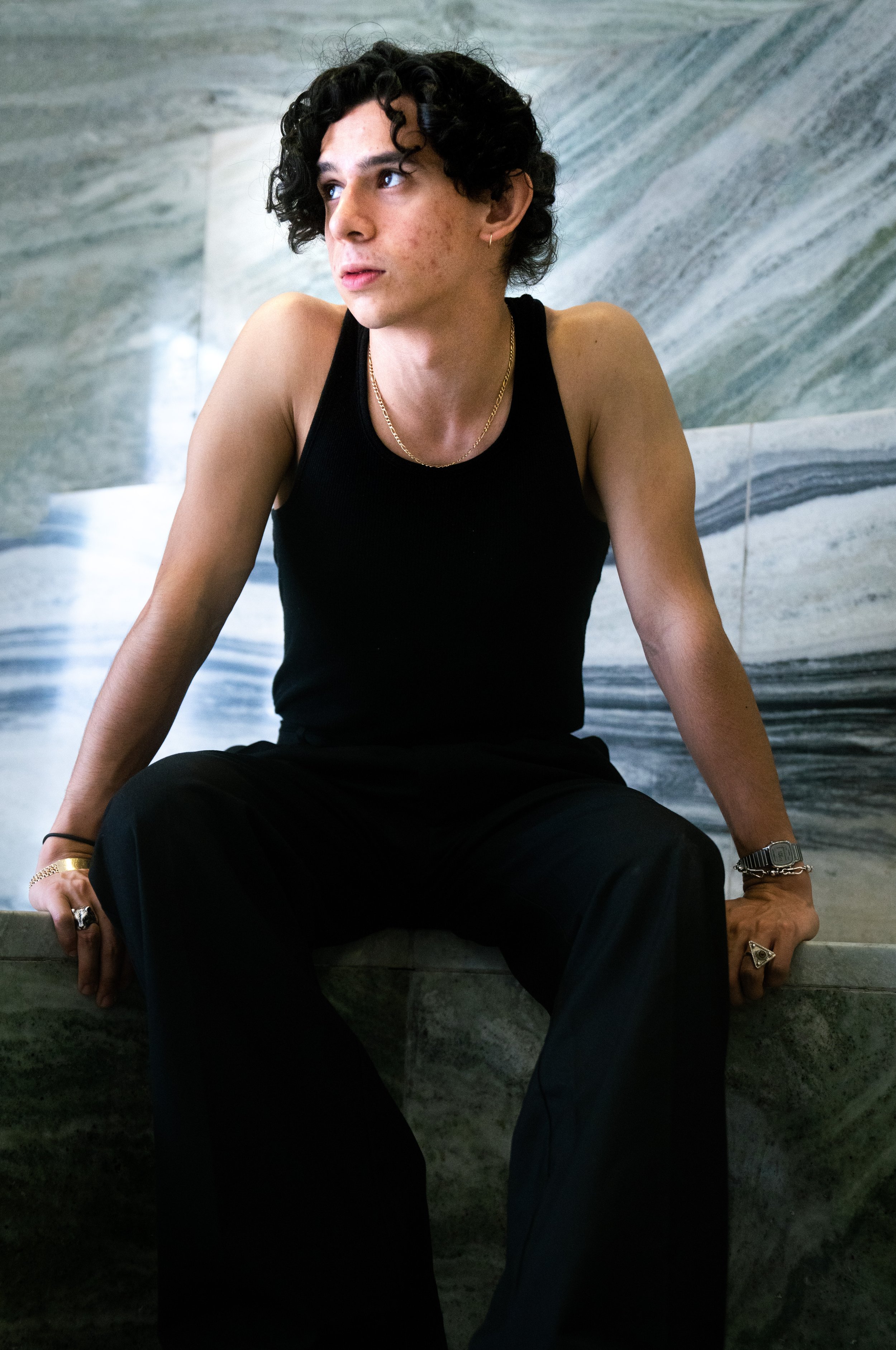Feature by Iker Veiga
Photos by Kendall Bartell
Rommel Nunez is a senior studying Computer Science and Film in SEAS as well as the President of Ratrock Magazine. Through his narrative photography and film, Nunez places viewers in the depths of the uncanny valley. His work dares the audience to overcome impossible visual labyrinths and engage in conversations that expand on their own identities. We met in Joe’s Coffee to discuss his musical background, barthesian theory, and the keys to keeping Columbia’s artistic community more alive than ever.
How did you start making art?
I do a lot of music videos nowadays, and I am convinced that all of that comes from my musical background. When I was 12, my parents bought me a $30 acoustic guitar, and that spurred my entire journey into making art. As I moved onto high school, I became really serious about music: I played classical saxophone, and it was the only thing I cared about. In college, however, I couldn't afford to own a saxophone, so I soon started looking for other ways to express myself. This struggle is essentially what motivated me to explore the visual arts.
My friend Gloria is a music producer, and when we were together here during our sophomore year, she would make one minute covers of her favorite songs, and post them on Instagram. I soon started making little music videos for them, and eventually, I ended up doing a longer version of a music video with Christina Li. By now I've made around 12 or 15 music videos in which I explore short film narrative techniques, and it's really exciting! There's a lot to work with when your art is so influenced by music.
What is more important to you when making a music video, coming up with evocative imagery, or focusing on exploring the narrative?
I think this is a big question I had to face when I first started doing this. At first, there weren't any rules. Nobody told me how to direct a music video, how to write a script, or how to come up with an original concept. It all is intuitive to me. Most of the time when coming up with an idea for a video, I sit down with the artist that I'm working with and they play the song for me. Then I close my eyes and focus on the sonic landscape the song evokes. And that's my little nugget – going off of that, the entire narrative starts coming together.
Then I work with index cards: I lay them out and make sure the story is cohesive. I also look at a ton of music videos for weeks to get inspiration. For instance, I worked on this music video by the artist Black Hibiscus for the song If I Cared. It's a song about unrequited love and trying to be with somebody who doesn't even know you exist. But the song has a trippy sonic aesthetic to it, and I wanted to capture that in the video as well. So I drew inspiration from a lot of different artists, – Bonobo, Adele – and what I ended up doing is that at the start of the video, you have this frame in which the artist is laying down on the couch wearing a black suit. And the whole idea is that, in the middle of the frame, you can see the next scene, so you can actually watch all the way through to the end of the clip in the center. And then, by the end, we discovered that he had taken drugs because he was so madly in love that he couldn't just help being by himself. Which is kind of dark, but in a way, a little romantic, you know?
Do you consider your art dark? What's the emotional atmosphere you want to achieve through your work?
Some of my art definitely goes deep into the uncanny valley. Especially my work with film photography and darkroom photography. There’s this photo of my friend Grace, in which her figure is really elongated and it looks very editorial. However, there's a version that I think a lot of people haven't seen, in which I decided to scratch her face off. I took the negative of the picture and stretched her face to make a haunting, alien-esque silhouette. And it's really scary. I'm really interested in exploring how black and white photography can bring out the obscurity behind each subject.
Currently I am working on translating that same aesthetic into my films. But it's really hard to accomplish the same effect in moving images. My college roommate got me into horror, and discovering that genre has affected my work a lot too. For a while, my favorite movie was Alien Covenant. I really admire Ridley Scott’s costume design and world building, he’s one of the best ever to do sci-fi.
However, I also draw inspiration from other film genres. I am fascinated by Roma. I watched it a year and a half ago, and I still think about it a lot. Because of my Mexican identity, I understand it differently: it hits so many beats that only Mexican people understand. When my mom watched it, she was like “Yeah, that's what Roma looked like when I was tiny.” And that tells me that it is a really, really well-made movie: it is informed by history and it reminds viewers of their own personal experience. I want to see more works like that. I want to tell stories that are real, that are diverse, that are something that people will be able to relate to.
Does your Mexican heritage influence your art in any other way?
The question of identity has been pervasive throughout my life. Growing up in high school, I couldn't really tell people that I was from Mexico, because I went to a public American high school when you're not supposed to commute across the border to go to school. I would go to class, be there for 10 hours, come back home to Mexico, do homework, and go to bed by like 10. It was when I started exploring darkroom photography that I first tried to incorporate my Mexican heritage with my work by learning from the work of past Mexican artists. For example, Armando Herrera invented what was essentially the first kind of Photoshop ever. After taking pictures, he would get big glass negatives and scratch the blemishes off the face of his models using a chisel. The results were these very characteristic portraits of the 40s and 50s in which people have beautiful porcelain faces. Thus, he defined the image of an entire generation in Mexico. And that’s what I want to do with my work, I want to be able to create iconic images that people can just look at and think “Oh, that’s Rommel.”
However, a lot of the work I consume isn’t exclusively Mexican, so many different influences filter and mix into my pieces. And that is beautiful. In the end, I'm just concerned with telling good stories–stories that ring true to the people I'm concerned with. I want to use my art to learn more about different cultures, especially Latin American cultures. I know Mexico really well. But I want to have cultural conversations with people in Ecuador, people in Venezuela… I hope that, through my art, I will at least help other people see themselves represented on the screen.
How do you reconcile storytelling and self-expression in your work?
When I write, the first thing that I focus on is character building. The best stories are stories in which the characters have a deep, embedded background. Through my creative process, I want to create real people. So I sit down, I open up a document, and I write three or four pages about who each character is, what they look like, how tall they are, what their skin color is, where they're from–all these questions that seem so stupid and unimportant in the grand scheme of things. Once you start writing a narrative, there is so much that you cannot tell in an under seven minutes short film that has to come out through subtext.
Nevertheless, that subtext is informed by the writer's history–my background. The big question that I've been struggling with as I write is “when am I writing about myself? When are characters influenced by my own experience?” Some of the characters I have written are Mexican, some of them are Colombian, some of them are my height, some of them love caffeine, some of them hate caffeine. All the small, stupid things about one’s life end up informing one’s characters. That is why there's so many people in my stories that are inverted versions of who I am and everything that I stand for. And that's fun. It's a big way of examining who you are, and diving deep into your own personal agenda.
Besides character development, what is your favorite part of the art-making process?
I have interacted with every part of the process because when you're starting off, you have to be really scrappy, and you don't have money to pay other people (asking for free labor doesn't feel right to me.) My favorite part, however, is being on set with people, especially when I am filming videos. I love the energy after setting up a good shot, cutting, and then having everybody in the room knowing that it looks fantastic.
I also love post processing in photography. The set-up of a picture is only 50% of a final image, because when you go back home, you have to edit it, get some cool colors out of it, and add different effects that will make the image look more impressive.
But I would say, I feel the most rewarded when I'm using a film camera. Because you never know what the image actually looks like through a screen – you have to use your intuition. You need to set up lights correctly, you have to get the right exposure… So it's just an amazing feeling to know that the image is solid when so many things could go wrong. In the past, I've shot entire rolls of film that were put on incorrectly, and I just didn't get any images from that, which sucks. But you live, you learn and when the images do turn out, it feels incredible, especially once you see people’s reactions to them.
What would you like your audience to experience when viewing your work?
I've been thinking about what I want my audience to experience when viewing my work a lot recently. I talk a lot about that with my friend Kate Miller, who is also my production designer in a lot of projects and a great artist herself–and we have started to realize that the best art is that which asks questions, it's an art that is kind of confusing. For example, I recently watched Tár, and it blew my mind. At the end of the movie, I couldn’t stop asking myself, should I feel bad for her? I really don't know. And I think that's what made it a really good movie, that it requires you to reconcile yourself with the artwork. Even though I'm always trying to reach an ideal punctum in my work, I think that it can live alongside a piece that invites a reader to dig deeper into them.
Can you tell us more about the punctum?
Barthes wrote a lot about this, we talked about it in my darkroom class last semester. According to him, there is a certain essence to a photograph that comes out only once the image has been displayed to the person looking at it. And it's debated whether that essence–that punctum–is built by the photographer, or if it's just a quality that pops out naturally from the image. And that annoys me a lot.
It's incredibly frustrating to me, because I like being in control, but people say that the punctum cannot be fabricated. I think I should be able to say what I want to say through my images because I construct them so intricately. And it's truly stupid to think that the way that the intention you create art with will be perceived by viewers without alterations. But the punctum complicates all of this even more. It is something we all chase: that accidental, impactful quality that enables people to viscerally relate to an image. And that's where the conflict in my work comes from: it's a race that I'm trying to win all the time. If I can achieve the punctum in three photographs in a row, I'll be happy. Because that means that I am figuring something out and getting closer to the core of photography.
Lastly, what are your thoughts on the artistic community at Columbia, both as a film student and as the President of Ratrock?
The first two years of my time here, I was really confused, because there were not that many creative people in my close circle. Sadly, there is a part of the Columbia experience that is about exclusion. I mean, clubs are literally exclusive groups of friends. Because of this, I think over sophomore, junior, and especially senior year, when I took over Ratrock, I wanted to foster a bigger, more inclusive community – I wanted people to feel like there truly was a space for them in this school. We have done that through different events, like the monthly general body meetings or the gallery shows that we have organized in ADP. That way we get to hang out as friends afterwards. Funny enough, I actually remember one time the Ratrock board was in a meeting, and I said “This is really fun, we should hang out as friends later.” And I said that because, I mean, even though Ratrock is a friends club, it still felt like a job for me sometimes, because I truly care so much about the mission. But it turns out that behind the scenes, everybody else felt like we were already hanging out as friends.
Everybody loves Ratrock!
You are biased, but I am happy people are making a lot of friends. What I want to leave to Columbia is this community of artists. Even if you are not one, the experience of having art around you is so important to a happy existence. It permeates your life, how you dress, and how you talk to people. It is ridiculous how much I have been influenced by art. The more people realize that, the better their lives will be.
Thank you for talking with us today! Where can the Ratrock readers find your art?
You can check my website out, and also my instagram is @rommelnunezg. I am also currently working on a short film about one of Alan Turing’s experiments, and am really excited for it to come together! Definitely check it out when it is out there. And please, hit me up for a job in film production after graduation, I am happy to help!













































